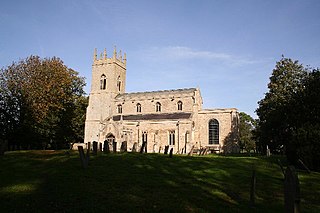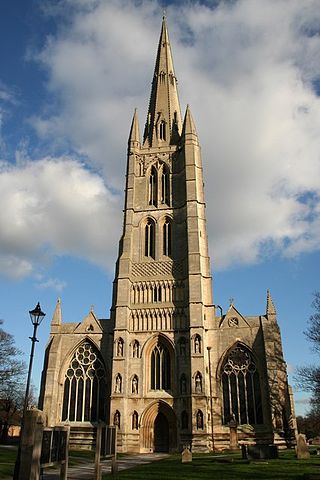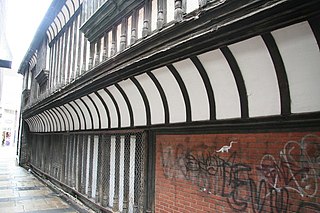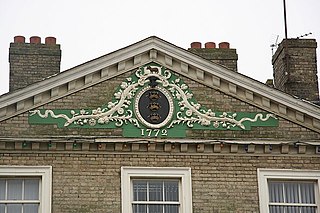
Howell is a village in the civil parish of Asgarby and Howell, in the North Kesteven district of Lincolnshire, England, approximately 1 mile (1.6 km) north of the A17, 4 miles (6 km) east from Sleaford, and 1.5 miles (2.4 km) north from Heckington. In 1921 the parish had a population of 58.

Honington is an English village and civil parish in the South Kesteven district of Lincolnshire. It lies just north of the junction between the A153 and A607 roads, about 5.5 miles (8.9 km) north of Grantham and 8 miles (12.9 km) west of Sleaford.

High Street in Lincoln, England extends from the St Catherine's roundabout and ends approximately 1.2 miles further north at The Strait. The historic High Street has evolved through many changes over its 2000 year history, encompassing Roman roads and settlement, medieval buildings, markets, places of worship, civic buildings, bridges, the arrival of the railways and heavy industry.

Hougham is a village and civil parish in the South Kesteven district of Lincolnshire, England, 6 miles (10 km) north from Grantham. The village of Marston, Lincolnshire is its closest neighbour, just under 1 mile (1.6 km) to the south.

St Wulfram's Church, Grantham, is the Anglican parish church of Grantham in Lincolnshire, England. The church is a Grade I listed building and has the second tallest spire in Lincolnshire after Louth's parish church.

St Denys' Church is a medieval Anglican parish church in Sleaford, Lincolnshire, England. While a church and a priest have probably been present in the settlement since approximately 1086, the oldest parts of the present building are the tower and spire, which date to the late 12th and early 13th centuries; the stone broach spire is one of the earliest examples of its kind in England. The Decorated Gothic nave, aisles and north transept were built in the 14th century. The church was altered in the 19th century: the north aisle was rebuilt by the local builders Kirk and Parry in 1853 and the tower and spire were largely rebuilt in 1884 after being struck by lightning. St Denys' remains an active parish church.

South Carlton is a village and civil parish in the West Lindsey district of Lincolnshire, England. It is situated on the B1398 road, approximately 2 miles (3 km) north from the city and county town of Lincoln. The population at the 2011 census was 168.

Gautby is a village in the East Lindsey district of Lincolnshire, England. The village is situated 6 miles (10 km) north-west from the town of Horncastle, and is part of the Minting civil parish.

William Adams Nicholson (1803–1853) was an English architect who worked in Lincoln and was a founding member of the Royal Institute of British Architects.

St Mary le Wigford is a Grade I listed parish church in Lincoln, England.

St Nicholas' Church is a Grade I listed Church of England parish church dedicated to Saint Nicholas, in Fulbeck, Lincolnshire, England. The church is 9 miles (14 km) north from Grantham, and at the southern edge of the Lincoln Cliff in South Kesteven.

Charles Bell FRIBA (1846–99) was a British architect who designed buildings in the United Kingdom, including over 60 Wesleyan Methodist chapels.

William Watkins (1834–1926) was an architect who worked in Lincoln, England, and is particularly noted for his Terracotta Revival Architecture.

A ledger stone or ledgerstone is an inscribed stone slab usually laid into the floor of a church to commemorate or mark the place of the burial of an important deceased person. The term "ledger" derives from the Middle English words lygger, ligger or leger, themselves derived from the root of the Old English verb liċġan, meaning to lie (down). Ledger stones may also be found as slabs forming the tops of tomb chest monuments.

Whitefriar or Akrill's Court is a 16th century timber-framed building in Lincoln. It now has a late 20th century shop front, but the timber-framed building survives with the southern front facing the narrow Akrill’s passage, on the east side of the High Street and just to the south of the railway crossing.

Michael Drury was an English architect working in Lincoln.

Thomas Lumby and William Lumby (c1755-1804) were master carpenters and architects working in Lincoln in the latter part of the 18th century. Thomas Lumby was the father of William. As they worked together and there is some confusion as which buildings each of them designed, they have been grouped together. It seems likely that after 1784, William Lumby had taken the business over from his father. Thomas Lumby undertook work at a number of major houses in Lincolnshire including Doddington Hall and Burghley House as well as building Caenby Hall and Corporation House (now the Exchange at Boston, Lincolnshire.

John Langwith, Sr. was an English carpenter and architect who worked in Grantham, Lincolnshire. His son John Langwith Jr. (c1753-1825) was also an architect who worked in Grantham.
Herbert Henry Dunn was an English architect who worked in Lincoln in the early 20th century before becoming the surveyor to the Cambridgeshire County Council. He designed buildings in Lincoln and Lincolnshire, before moving to Cambridgeshire shortly before the 1st World War. His most notable buildings in Cambridge are the County Hall which is now part of Christ's College and the Cambridgeshire Shire Hall. Dunn was also the architect for the pioneering Sawston Village College.

The Church of St Peter and St Paul, Belton, South Kesteven, Lincolnshire is a functioning parish church and a Grade I listed building. Since the 17th century, the church has served as the estate church for Belton House and it holds a notable collection of funerary monuments commemorating members of the Brownlow family.

























